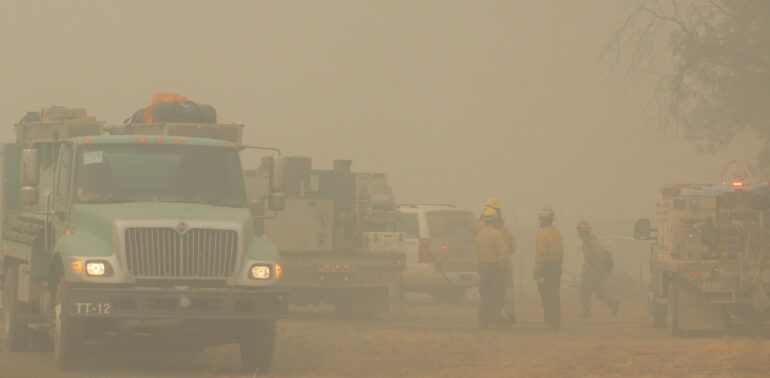The smoke from intense California wildfires in September 2020 darkened the skies so much that it slashed the state’s solar power production during peak hours by 10–30%, according to a study led by scientists at the National Center for Atmospheric Research (NCAR). This meant that solar energy forecasts for several days substantially overestimated the amount of power that would be generated by the sun.
The study drew on advanced computer models of wildfire smoke and meteorological conditions, as well as records of solar irradiance and energy production. Although previous research looked at the impact of 2020 wildfires on solar energy production, the new study is notable for using a specialized weather forecasting model, pointing the way to developing systems that can better predict smoke impacts.
“The key takeaway from this research is that wildfire smoke can have a substantial and negative impact on solar energy production in areas near major wildfires,” said NCAR scientist Timothy Juliano, the lead author. “This is something that utilities should keep in mind when wildfires occur.”
The study was published earlier this year in Environmental Research Letters.
Heavy smoke, low irradiance
The 2020 wildfire season featured half of the 10 largest wildfires in California history, including the August Complex, which set the state record by burning more than 1 million acres. In early and mid September, dry and windy conditions in California and much of the West were particularly conducive to wildfires, and satellites showed clear images of expansive smoke plumes.
Juliano and his colleagues focused their study on smoke conditions during Sept. 7–16, 2020, when the fires were peaking. To determine the amount of solar energy generated at various sites across the state, they drew on data from the California Independent System Operator.
They compared the energy output with the same period in September during the two previous years, when solar arrays produced far more energy. They also analyzed data from ground stations in California and elsewhere in the United States that take minute-by-minute measurements of incoming solar radiation, or irradiance.
These observations enabled them to quantify the impacts of smoke on solar energy. During days of heavy smoke, irradiance was sharply reduced and energy production plummeted 10–30% between noon and 4 p.m., compared with the same days in previous years.
But on days when winds blew much of the smoke out of the region, such as occurred on Sept. 9 and Sept. 12–16, solar production declined by less than 7%. Although the scientists focused on areas in California near the fires, Juliano said other regions of the country where the smoke dispersed likely experienced a smaller decline in solar energy.
The smoke significantly affected the accuracy of energy predictions in California. During the smokiest days, solar energy production averaged 27% less than forecast. Moreover, it fell to as much as 50% less than forecast during late afternoon and evening hours that coincide with the largest ramp-up in energy demand.
To determine if the forecasts can be improved, the scientists next turned to an NCAR-based model known as Weather Research and Forecasting-Solar, which leverages recent technological advances to enhance solar irradiance predictions. By inputting data about the smoke, including various airborne particles (known as aerosols) that have differing impact on sunlight, they were able to better approximate the magnitude and timing of solar irradiance. They ran the model simulations on the Cheyenne supercomputer at the NCAR-Wyoming Supercomputing Center.
Juliano emphasized that wildfire activity seldom affects solar energy to the extent that it did in California in 2020. But with wildfires becoming more common and smoke plumes sometimes extending over large swaths of the nation, the study concluded that scientists need to continue working to better predict smoke impacts—an effort that will require collaborations among experts in different disciplines, including fire behavior, weather, and renewable energy.
“Wildfire smoke can be quite an important factor in energy production,” Juliano said. “Given the increase in large wildfires and society’s greater reliance on solar energy, even regions far downwind of fires may need to consider the potential impacts of smoke.”
More information:
Timothy W Juliano et al, Smoke from 2020 United States wildfires responsible for substantial solar energy forecast errors, Environmental Research Letters (2022). DOI: 10.1088/1748-9326/ac5143
Citation:
California wildfire smoke dimmed solar energy in 2020 (2022, December 8)



